Examining Organisational Behaviour Concepts at Sainsbury
VerifiedAdded on 2023/06/15
|14
|4279
|219
Report
AI Summary
This report provides an analysis of organisational behaviour within Sainsbury, a major supermarket chain in the United Kingdom. It explores how organisational culture, politics, and power influence individual and team behaviour and performance. The report discusses Handy's cultural model, including power, role, task, and person cultures, suggesting that Sainsbury could benefit from adopting a task culture to enhance teamwork and goal achievement. It also examines different types of organisational power, such as legitimate, expert, reward, referent, and coercive power, recommending the use of legitimate and reward power to motivate employees effectively. Furthermore, the report addresses organisational politics, highlighting its potential negative impacts on productivity and motivation, and suggests strategies to mitigate these effects through delegation, team networking, and communication. The evaluation of content and process theories of motivation, including Maslow's hierarchy of needs and Alderfer's ERG theory, provides insights into motivational techniques for achieving organisational goals. Desklib provides past papers and solved assignments for students.
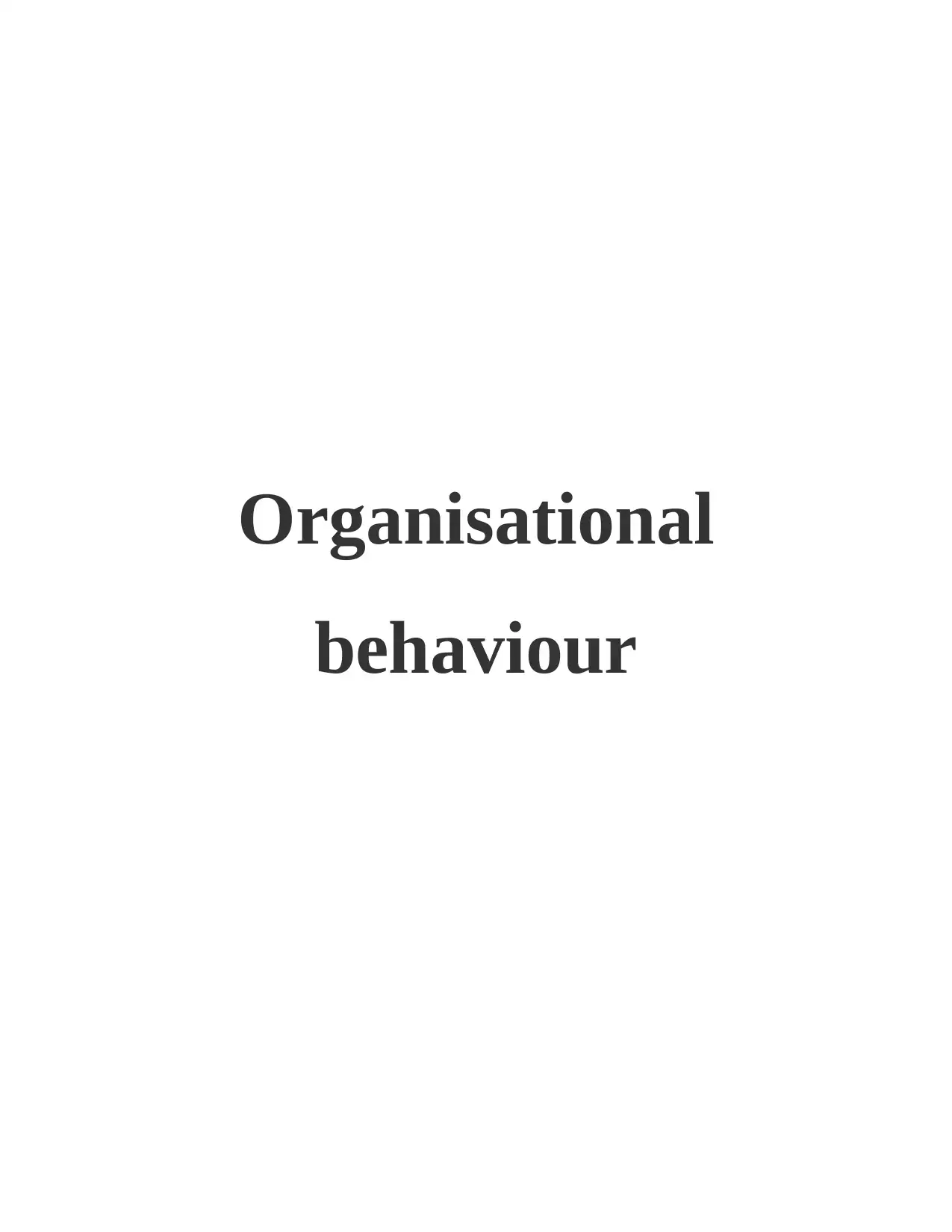
Organisational
behaviour
behaviour
Paraphrase This Document
Need a fresh take? Get an instant paraphrase of this document with our AI Paraphraser
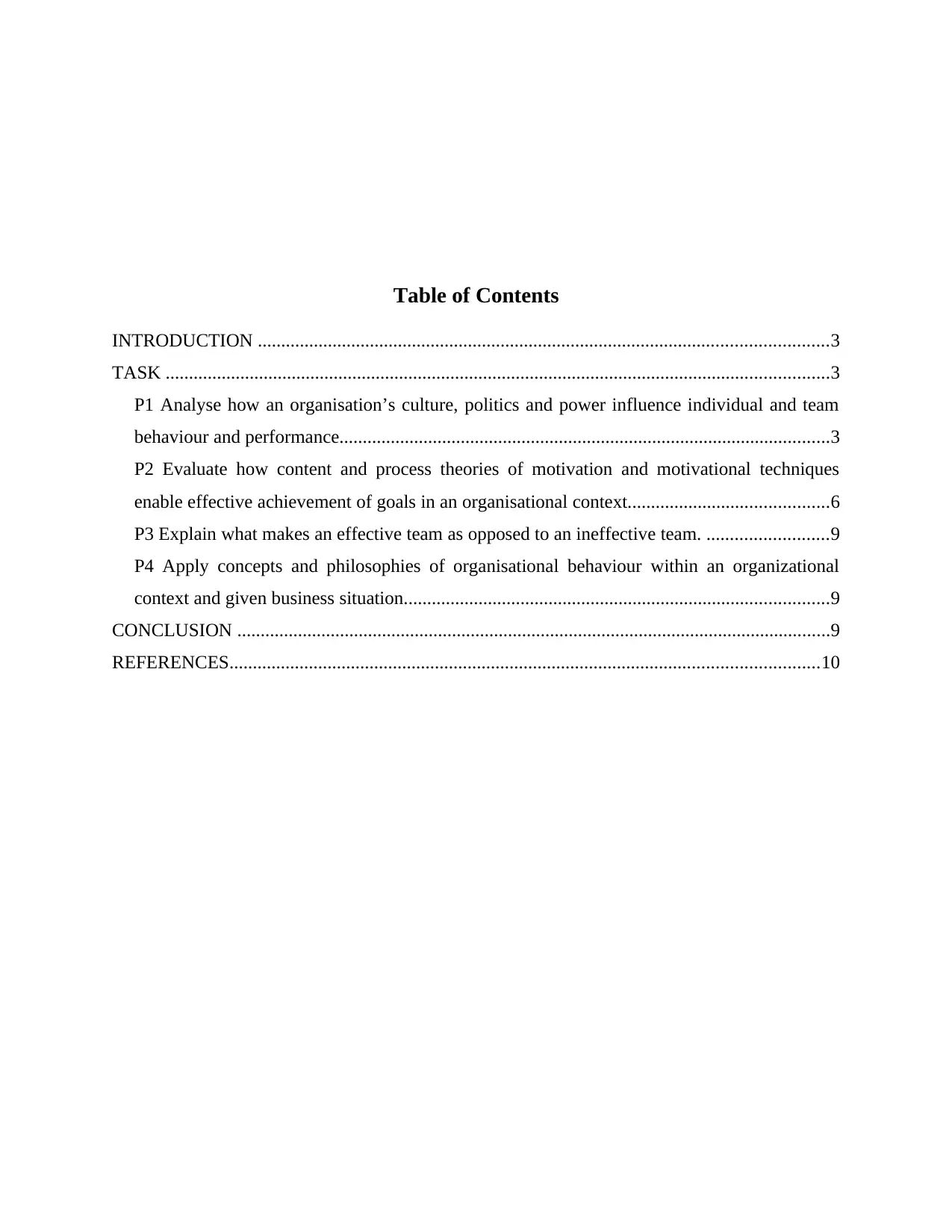
Table of Contents
INTRODUCTION ..........................................................................................................................3
TASK ..............................................................................................................................................3
P1 Analyse how an organisation’s culture, politics and power influence individual and team
behaviour and performance.........................................................................................................3
P2 Evaluate how content and process theories of motivation and motivational techniques
enable effective achievement of goals in an organisational context...........................................6
P3 Explain what makes an effective team as opposed to an ineffective team. ..........................9
P4 Apply concepts and philosophies of organisational behaviour within an organizational
context and given business situation...........................................................................................9
CONCLUSION ...............................................................................................................................9
REFERENCES..............................................................................................................................10
INTRODUCTION ..........................................................................................................................3
TASK ..............................................................................................................................................3
P1 Analyse how an organisation’s culture, politics and power influence individual and team
behaviour and performance.........................................................................................................3
P2 Evaluate how content and process theories of motivation and motivational techniques
enable effective achievement of goals in an organisational context...........................................6
P3 Explain what makes an effective team as opposed to an ineffective team. ..........................9
P4 Apply concepts and philosophies of organisational behaviour within an organizational
context and given business situation...........................................................................................9
CONCLUSION ...............................................................................................................................9
REFERENCES..............................................................................................................................10
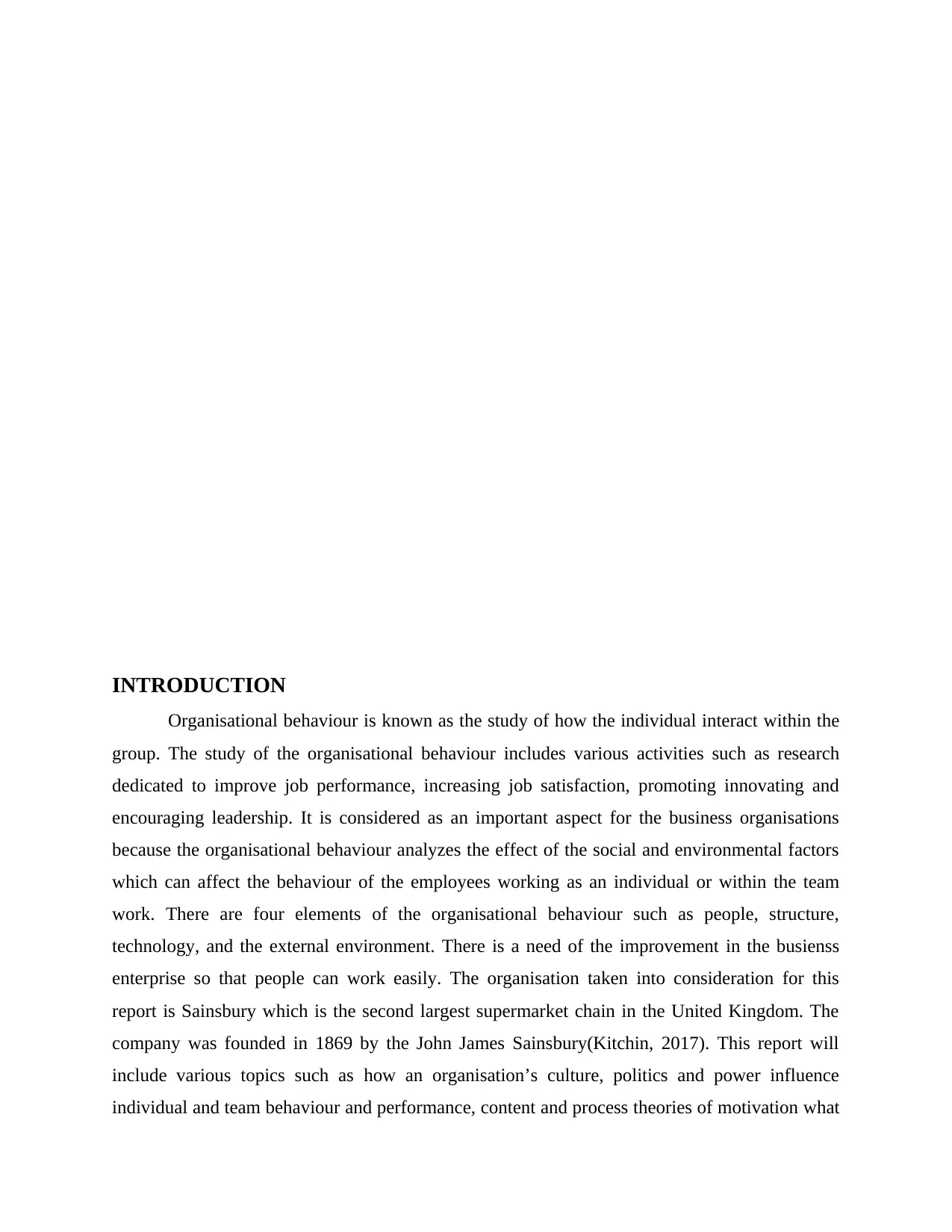
INTRODUCTION
Organisational behaviour is known as the study of how the individual interact within the
group. The study of the organisational behaviour includes various activities such as research
dedicated to improve job performance, increasing job satisfaction, promoting innovating and
encouraging leadership. It is considered as an important aspect for the business organisations
because the organisational behaviour analyzes the effect of the social and environmental factors
which can affect the behaviour of the employees working as an individual or within the team
work. There are four elements of the organisational behaviour such as people, structure,
technology, and the external environment. There is a need of the improvement in the busienss
enterprise so that people can work easily. The organisation taken into consideration for this
report is Sainsbury which is the second largest supermarket chain in the United Kingdom. The
company was founded in 1869 by the John James Sainsbury(Kitchin, 2017). This report will
include various topics such as how an organisation’s culture, politics and power influence
individual and team behaviour and performance, content and process theories of motivation what
Organisational behaviour is known as the study of how the individual interact within the
group. The study of the organisational behaviour includes various activities such as research
dedicated to improve job performance, increasing job satisfaction, promoting innovating and
encouraging leadership. It is considered as an important aspect for the business organisations
because the organisational behaviour analyzes the effect of the social and environmental factors
which can affect the behaviour of the employees working as an individual or within the team
work. There are four elements of the organisational behaviour such as people, structure,
technology, and the external environment. There is a need of the improvement in the busienss
enterprise so that people can work easily. The organisation taken into consideration for this
report is Sainsbury which is the second largest supermarket chain in the United Kingdom. The
company was founded in 1869 by the John James Sainsbury(Kitchin, 2017). This report will
include various topics such as how an organisation’s culture, politics and power influence
individual and team behaviour and performance, content and process theories of motivation what
⊘ This is a preview!⊘
Do you want full access?
Subscribe today to unlock all pages.

Trusted by 1+ million students worldwide
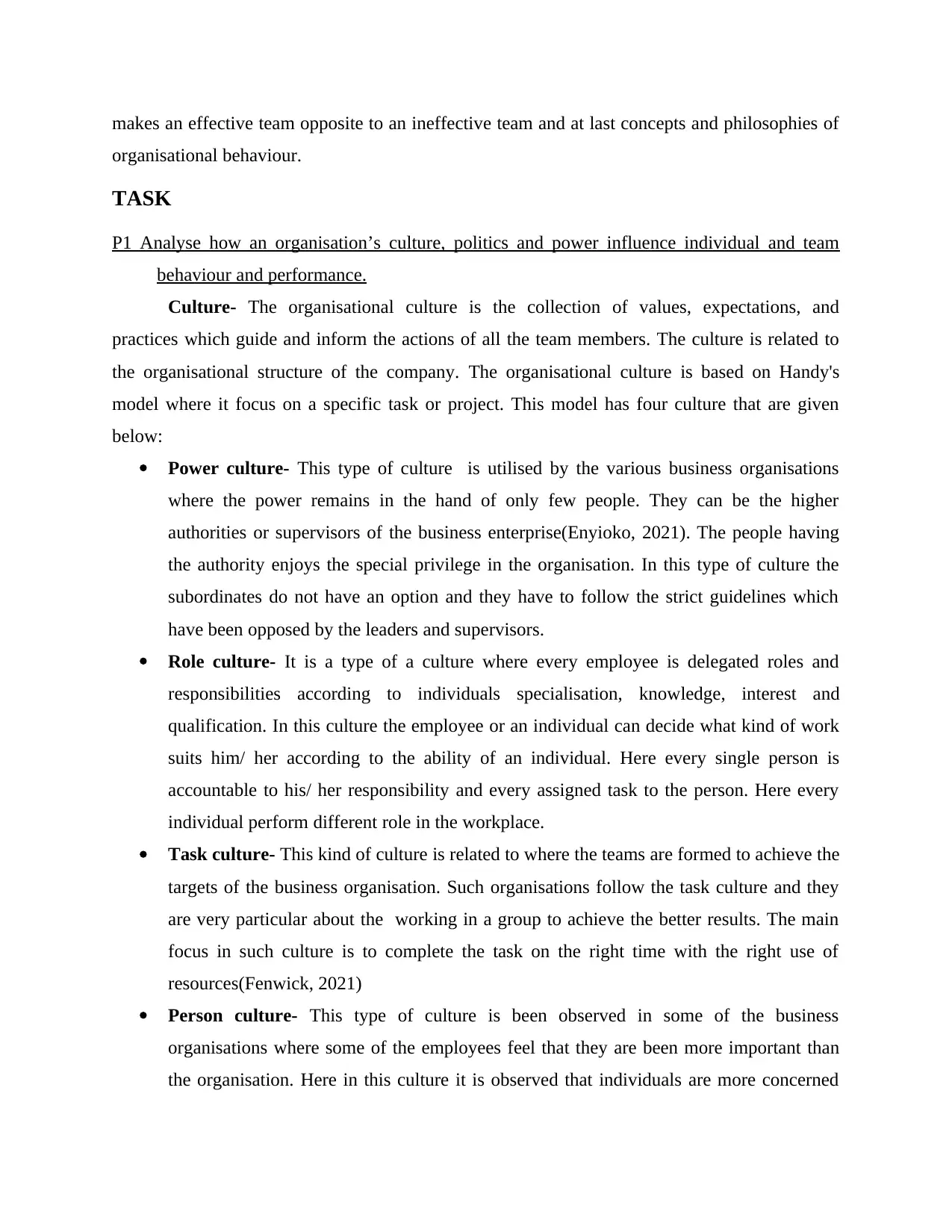
makes an effective team opposite to an ineffective team and at last concepts and philosophies of
organisational behaviour.
TASK
P1 Analyse how an organisation’s culture, politics and power influence individual and team
behaviour and performance.
Culture- The organisational culture is the collection of values, expectations, and
practices which guide and inform the actions of all the team members. The culture is related to
the organisational structure of the company. The organisational culture is based on Handy's
model where it focus on a specific task or project. This model has four culture that are given
below:
Power culture- This type of culture is utilised by the various business organisations
where the power remains in the hand of only few people. They can be the higher
authorities or supervisors of the business enterprise(Enyioko, 2021). The people having
the authority enjoys the special privilege in the organisation. In this type of culture the
subordinates do not have an option and they have to follow the strict guidelines which
have been opposed by the leaders and supervisors.
Role culture- It is a type of a culture where every employee is delegated roles and
responsibilities according to individuals specialisation, knowledge, interest and
qualification. In this culture the employee or an individual can decide what kind of work
suits him/ her according to the ability of an individual. Here every single person is
accountable to his/ her responsibility and every assigned task to the person. Here every
individual perform different role in the workplace.
Task culture- This kind of culture is related to where the teams are formed to achieve the
targets of the business organisation. Such organisations follow the task culture and they
are very particular about the working in a group to achieve the better results. The main
focus in such culture is to complete the task on the right time with the right use of
resources(Fenwick, 2021)
Person culture- This type of culture is been observed in some of the business
organisations where some of the employees feel that they are been more important than
the organisation. Here in this culture it is observed that individuals are more concerned
organisational behaviour.
TASK
P1 Analyse how an organisation’s culture, politics and power influence individual and team
behaviour and performance.
Culture- The organisational culture is the collection of values, expectations, and
practices which guide and inform the actions of all the team members. The culture is related to
the organisational structure of the company. The organisational culture is based on Handy's
model where it focus on a specific task or project. This model has four culture that are given
below:
Power culture- This type of culture is utilised by the various business organisations
where the power remains in the hand of only few people. They can be the higher
authorities or supervisors of the business enterprise(Enyioko, 2021). The people having
the authority enjoys the special privilege in the organisation. In this type of culture the
subordinates do not have an option and they have to follow the strict guidelines which
have been opposed by the leaders and supervisors.
Role culture- It is a type of a culture where every employee is delegated roles and
responsibilities according to individuals specialisation, knowledge, interest and
qualification. In this culture the employee or an individual can decide what kind of work
suits him/ her according to the ability of an individual. Here every single person is
accountable to his/ her responsibility and every assigned task to the person. Here every
individual perform different role in the workplace.
Task culture- This kind of culture is related to where the teams are formed to achieve the
targets of the business organisation. Such organisations follow the task culture and they
are very particular about the working in a group to achieve the better results. The main
focus in such culture is to complete the task on the right time with the right use of
resources(Fenwick, 2021)
Person culture- This type of culture is been observed in some of the business
organisations where some of the employees feel that they are been more important than
the organisation. Here in this culture it is observed that individuals are more concerned
Paraphrase This Document
Need a fresh take? Get an instant paraphrase of this document with our AI Paraphraser
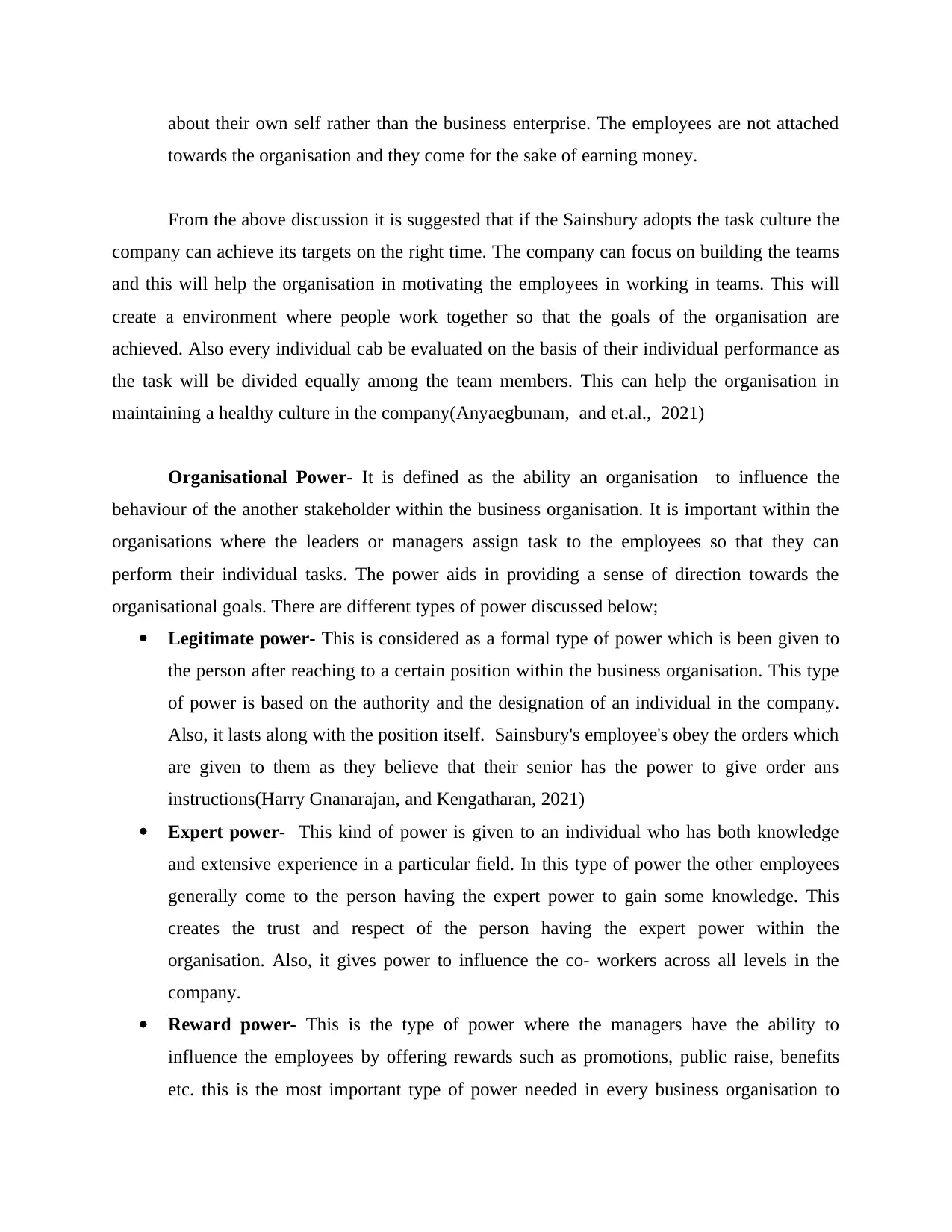
about their own self rather than the business enterprise. The employees are not attached
towards the organisation and they come for the sake of earning money.
From the above discussion it is suggested that if the Sainsbury adopts the task culture the
company can achieve its targets on the right time. The company can focus on building the teams
and this will help the organisation in motivating the employees in working in teams. This will
create a environment where people work together so that the goals of the organisation are
achieved. Also every individual cab be evaluated on the basis of their individual performance as
the task will be divided equally among the team members. This can help the organisation in
maintaining a healthy culture in the company(Anyaegbunam, and et.al., 2021)
Organisational Power- It is defined as the ability an organisation to influence the
behaviour of the another stakeholder within the business organisation. It is important within the
organisations where the leaders or managers assign task to the employees so that they can
perform their individual tasks. The power aids in providing a sense of direction towards the
organisational goals. There are different types of power discussed below;
Legitimate power- This is considered as a formal type of power which is been given to
the person after reaching to a certain position within the business organisation. This type
of power is based on the authority and the designation of an individual in the company.
Also, it lasts along with the position itself. Sainsbury's employee's obey the orders which
are given to them as they believe that their senior has the power to give order ans
instructions(Harry Gnanarajan, and Kengatharan, 2021)
Expert power- This kind of power is given to an individual who has both knowledge
and extensive experience in a particular field. In this type of power the other employees
generally come to the person having the expert power to gain some knowledge. This
creates the trust and respect of the person having the expert power within the
organisation. Also, it gives power to influence the co- workers across all levels in the
company.
Reward power- This is the type of power where the managers have the ability to
influence the employees by offering rewards such as promotions, public raise, benefits
etc. this is the most important type of power needed in every business organisation to
towards the organisation and they come for the sake of earning money.
From the above discussion it is suggested that if the Sainsbury adopts the task culture the
company can achieve its targets on the right time. The company can focus on building the teams
and this will help the organisation in motivating the employees in working in teams. This will
create a environment where people work together so that the goals of the organisation are
achieved. Also every individual cab be evaluated on the basis of their individual performance as
the task will be divided equally among the team members. This can help the organisation in
maintaining a healthy culture in the company(Anyaegbunam, and et.al., 2021)
Organisational Power- It is defined as the ability an organisation to influence the
behaviour of the another stakeholder within the business organisation. It is important within the
organisations where the leaders or managers assign task to the employees so that they can
perform their individual tasks. The power aids in providing a sense of direction towards the
organisational goals. There are different types of power discussed below;
Legitimate power- This is considered as a formal type of power which is been given to
the person after reaching to a certain position within the business organisation. This type
of power is based on the authority and the designation of an individual in the company.
Also, it lasts along with the position itself. Sainsbury's employee's obey the orders which
are given to them as they believe that their senior has the power to give order ans
instructions(Harry Gnanarajan, and Kengatharan, 2021)
Expert power- This kind of power is given to an individual who has both knowledge
and extensive experience in a particular field. In this type of power the other employees
generally come to the person having the expert power to gain some knowledge. This
creates the trust and respect of the person having the expert power within the
organisation. Also, it gives power to influence the co- workers across all levels in the
company.
Reward power- This is the type of power where the managers have the ability to
influence the employees by offering rewards such as promotions, public raise, benefits
etc. this is the most important type of power needed in every business organisation to
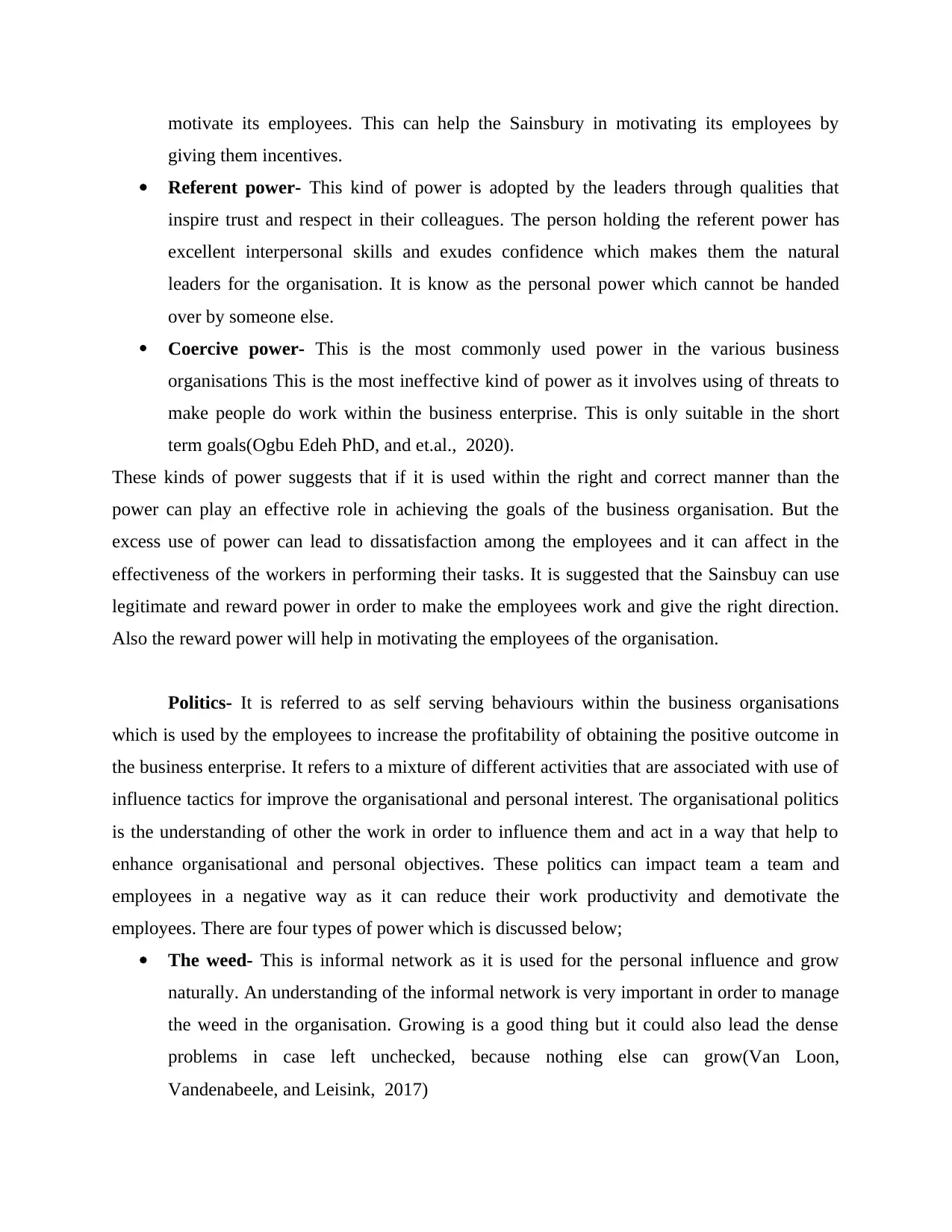
motivate its employees. This can help the Sainsbury in motivating its employees by
giving them incentives.
Referent power- This kind of power is adopted by the leaders through qualities that
inspire trust and respect in their colleagues. The person holding the referent power has
excellent interpersonal skills and exudes confidence which makes them the natural
leaders for the organisation. It is know as the personal power which cannot be handed
over by someone else.
Coercive power- This is the most commonly used power in the various business
organisations This is the most ineffective kind of power as it involves using of threats to
make people do work within the business enterprise. This is only suitable in the short
term goals(Ogbu Edeh PhD, and et.al., 2020).
These kinds of power suggests that if it is used within the right and correct manner than the
power can play an effective role in achieving the goals of the business organisation. But the
excess use of power can lead to dissatisfaction among the employees and it can affect in the
effectiveness of the workers in performing their tasks. It is suggested that the Sainsbuy can use
legitimate and reward power in order to make the employees work and give the right direction.
Also the reward power will help in motivating the employees of the organisation.
Politics- It is referred to as self serving behaviours within the business organisations
which is used by the employees to increase the profitability of obtaining the positive outcome in
the business enterprise. It refers to a mixture of different activities that are associated with use of
influence tactics for improve the organisational and personal interest. The organisational politics
is the understanding of other the work in order to influence them and act in a way that help to
enhance organisational and personal objectives. These politics can impact team a team and
employees in a negative way as it can reduce their work productivity and demotivate the
employees. There are four types of power which is discussed below;
The weed- This is informal network as it is used for the personal influence and grow
naturally. An understanding of the informal network is very important in order to manage
the weed in the organisation. Growing is a good thing but it could also lead the dense
problems in case left unchecked, because nothing else can grow(Van Loon,
Vandenabeele, and Leisink, 2017)
giving them incentives.
Referent power- This kind of power is adopted by the leaders through qualities that
inspire trust and respect in their colleagues. The person holding the referent power has
excellent interpersonal skills and exudes confidence which makes them the natural
leaders for the organisation. It is know as the personal power which cannot be handed
over by someone else.
Coercive power- This is the most commonly used power in the various business
organisations This is the most ineffective kind of power as it involves using of threats to
make people do work within the business enterprise. This is only suitable in the short
term goals(Ogbu Edeh PhD, and et.al., 2020).
These kinds of power suggests that if it is used within the right and correct manner than the
power can play an effective role in achieving the goals of the business organisation. But the
excess use of power can lead to dissatisfaction among the employees and it can affect in the
effectiveness of the workers in performing their tasks. It is suggested that the Sainsbuy can use
legitimate and reward power in order to make the employees work and give the right direction.
Also the reward power will help in motivating the employees of the organisation.
Politics- It is referred to as self serving behaviours within the business organisations
which is used by the employees to increase the profitability of obtaining the positive outcome in
the business enterprise. It refers to a mixture of different activities that are associated with use of
influence tactics for improve the organisational and personal interest. The organisational politics
is the understanding of other the work in order to influence them and act in a way that help to
enhance organisational and personal objectives. These politics can impact team a team and
employees in a negative way as it can reduce their work productivity and demotivate the
employees. There are four types of power which is discussed below;
The weed- This is informal network as it is used for the personal influence and grow
naturally. An understanding of the informal network is very important in order to manage
the weed in the organisation. Growing is a good thing but it could also lead the dense
problems in case left unchecked, because nothing else can grow(Van Loon,
Vandenabeele, and Leisink, 2017)
⊘ This is a preview!⊘
Do you want full access?
Subscribe today to unlock all pages.

Trusted by 1+ million students worldwide
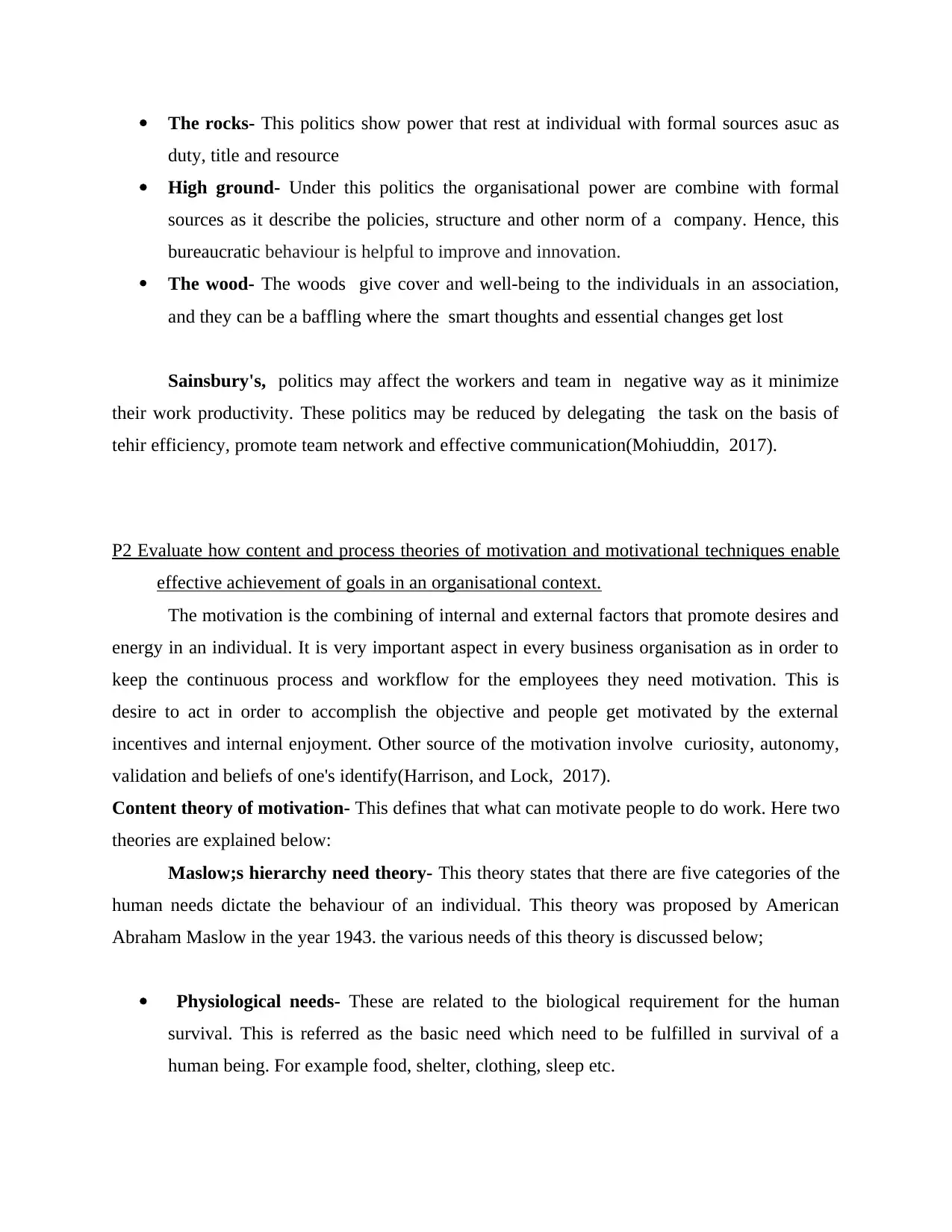
The rocks- This politics show power that rest at individual with formal sources asuc as
duty, title and resource
High ground- Under this politics the organisational power are combine with formal
sources as it describe the policies, structure and other norm of a company. Hence, this
bureaucratic behaviour is helpful to improve and innovation.
The wood- The woods give cover and well-being to the individuals in an association,
and they can be a baffling where the smart thoughts and essential changes get lost
Sainsbury's, politics may affect the workers and team in negative way as it minimize
their work productivity. These politics may be reduced by delegating the task on the basis of
tehir efficiency, promote team network and effective communication(Mohiuddin, 2017).
P2 Evaluate how content and process theories of motivation and motivational techniques enable
effective achievement of goals in an organisational context.
The motivation is the combining of internal and external factors that promote desires and
energy in an individual. It is very important aspect in every business organisation as in order to
keep the continuous process and workflow for the employees they need motivation. This is
desire to act in order to accomplish the objective and people get motivated by the external
incentives and internal enjoyment. Other source of the motivation involve curiosity, autonomy,
validation and beliefs of one's identify(Harrison, and Lock, 2017).
Content theory of motivation- This defines that what can motivate people to do work. Here two
theories are explained below:
Maslow;s hierarchy need theory- This theory states that there are five categories of the
human needs dictate the behaviour of an individual. This theory was proposed by American
Abraham Maslow in the year 1943. the various needs of this theory is discussed below;
Physiological needs- These are related to the biological requirement for the human
survival. This is referred as the basic need which need to be fulfilled in survival of a
human being. For example food, shelter, clothing, sleep etc.
duty, title and resource
High ground- Under this politics the organisational power are combine with formal
sources as it describe the policies, structure and other norm of a company. Hence, this
bureaucratic behaviour is helpful to improve and innovation.
The wood- The woods give cover and well-being to the individuals in an association,
and they can be a baffling where the smart thoughts and essential changes get lost
Sainsbury's, politics may affect the workers and team in negative way as it minimize
their work productivity. These politics may be reduced by delegating the task on the basis of
tehir efficiency, promote team network and effective communication(Mohiuddin, 2017).
P2 Evaluate how content and process theories of motivation and motivational techniques enable
effective achievement of goals in an organisational context.
The motivation is the combining of internal and external factors that promote desires and
energy in an individual. It is very important aspect in every business organisation as in order to
keep the continuous process and workflow for the employees they need motivation. This is
desire to act in order to accomplish the objective and people get motivated by the external
incentives and internal enjoyment. Other source of the motivation involve curiosity, autonomy,
validation and beliefs of one's identify(Harrison, and Lock, 2017).
Content theory of motivation- This defines that what can motivate people to do work. Here two
theories are explained below:
Maslow;s hierarchy need theory- This theory states that there are five categories of the
human needs dictate the behaviour of an individual. This theory was proposed by American
Abraham Maslow in the year 1943. the various needs of this theory is discussed below;
Physiological needs- These are related to the biological requirement for the human
survival. This is referred as the basic need which need to be fulfilled in survival of a
human being. For example food, shelter, clothing, sleep etc.
Paraphrase This Document
Need a fresh take? Get an instant paraphrase of this document with our AI Paraphraser
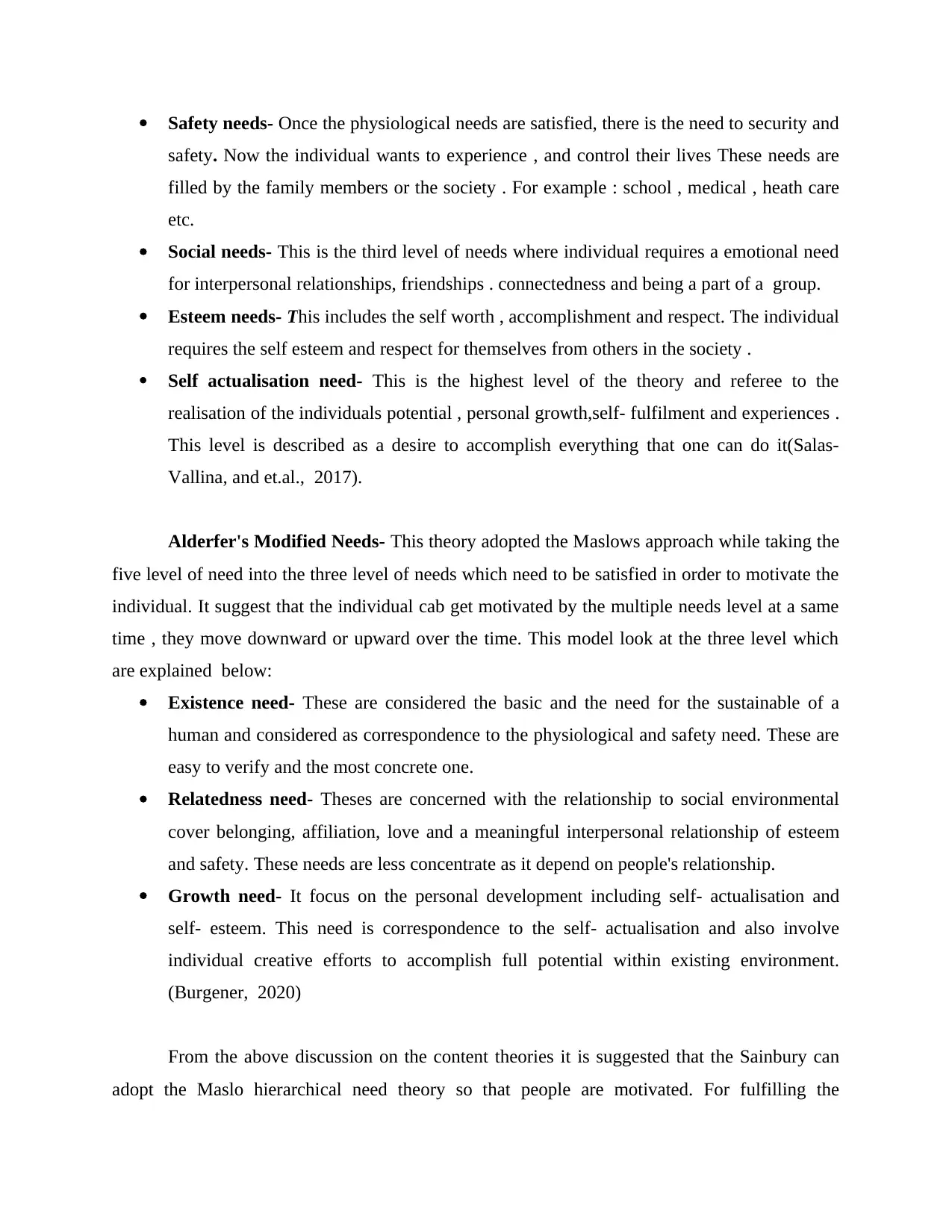
Safety needs- Once the physiological needs are satisfied, there is the need to security and
safety. Now the individual wants to experience , and control their lives These needs are
filled by the family members or the society . For example : school , medical , heath care
etc.
Social needs- This is the third level of needs where individual requires a emotional need
for interpersonal relationships, friendships . connectedness and being a part of a group.
Esteem needs- This includes the self worth , accomplishment and respect. The individual
requires the self esteem and respect for themselves from others in the society .
Self actualisation need- This is the highest level of the theory and referee to the
realisation of the individuals potential , personal growth,self- fulfilment and experiences .
This level is described as a desire to accomplish everything that one can do it(Salas-
Vallina, and et.al., 2017).
Alderfer's Modified Needs- This theory adopted the Maslows approach while taking the
five level of need into the three level of needs which need to be satisfied in order to motivate the
individual. It suggest that the individual cab get motivated by the multiple needs level at a same
time , they move downward or upward over the time. This model look at the three level which
are explained below:
Existence need- These are considered the basic and the need for the sustainable of a
human and considered as correspondence to the physiological and safety need. These are
easy to verify and the most concrete one.
Relatedness need- Theses are concerned with the relationship to social environmental
cover belonging, affiliation, love and a meaningful interpersonal relationship of esteem
and safety. These needs are less concentrate as it depend on people's relationship.
Growth need- It focus on the personal development including self- actualisation and
self- esteem. This need is correspondence to the self- actualisation and also involve
individual creative efforts to accomplish full potential within existing environment.
(Burgener, 2020)
From the above discussion on the content theories it is suggested that the Sainbury can
adopt the Maslo hierarchical need theory so that people are motivated. For fulfilling the
safety. Now the individual wants to experience , and control their lives These needs are
filled by the family members or the society . For example : school , medical , heath care
etc.
Social needs- This is the third level of needs where individual requires a emotional need
for interpersonal relationships, friendships . connectedness and being a part of a group.
Esteem needs- This includes the self worth , accomplishment and respect. The individual
requires the self esteem and respect for themselves from others in the society .
Self actualisation need- This is the highest level of the theory and referee to the
realisation of the individuals potential , personal growth,self- fulfilment and experiences .
This level is described as a desire to accomplish everything that one can do it(Salas-
Vallina, and et.al., 2017).
Alderfer's Modified Needs- This theory adopted the Maslows approach while taking the
five level of need into the three level of needs which need to be satisfied in order to motivate the
individual. It suggest that the individual cab get motivated by the multiple needs level at a same
time , they move downward or upward over the time. This model look at the three level which
are explained below:
Existence need- These are considered the basic and the need for the sustainable of a
human and considered as correspondence to the physiological and safety need. These are
easy to verify and the most concrete one.
Relatedness need- Theses are concerned with the relationship to social environmental
cover belonging, affiliation, love and a meaningful interpersonal relationship of esteem
and safety. These needs are less concentrate as it depend on people's relationship.
Growth need- It focus on the personal development including self- actualisation and
self- esteem. This need is correspondence to the self- actualisation and also involve
individual creative efforts to accomplish full potential within existing environment.
(Burgener, 2020)
From the above discussion on the content theories it is suggested that the Sainbury can
adopt the Maslo hierarchical need theory so that people are motivated. For fulfilling the
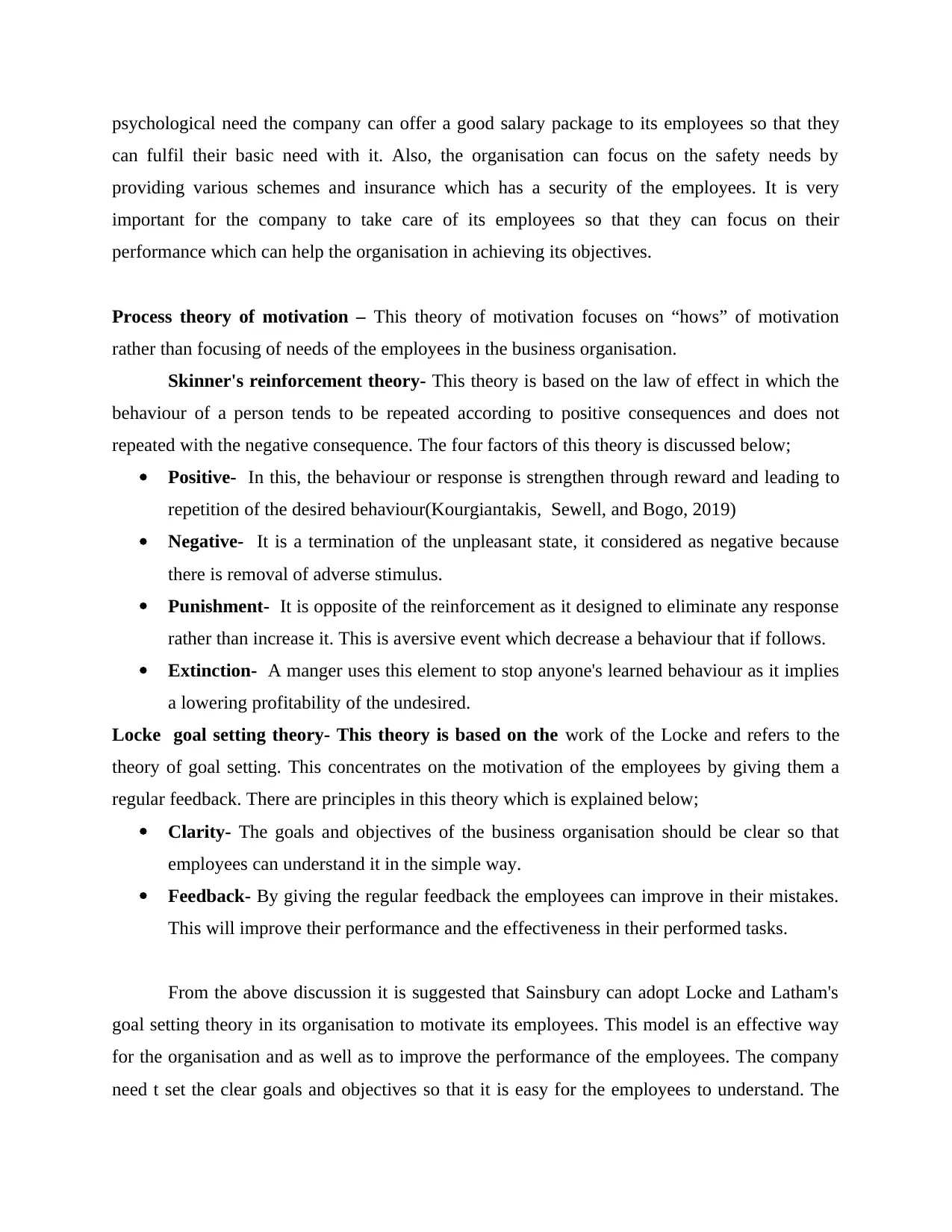
psychological need the company can offer a good salary package to its employees so that they
can fulfil their basic need with it. Also, the organisation can focus on the safety needs by
providing various schemes and insurance which has a security of the employees. It is very
important for the company to take care of its employees so that they can focus on their
performance which can help the organisation in achieving its objectives.
Process theory of motivation – This theory of motivation focuses on “hows” of motivation
rather than focusing of needs of the employees in the business organisation.
Skinner's reinforcement theory- This theory is based on the law of effect in which the
behaviour of a person tends to be repeated according to positive consequences and does not
repeated with the negative consequence. The four factors of this theory is discussed below;
Positive- In this, the behaviour or response is strengthen through reward and leading to
repetition of the desired behaviour(Kourgiantakis, Sewell, and Bogo, 2019)
Negative- It is a termination of the unpleasant state, it considered as negative because
there is removal of adverse stimulus.
Punishment- It is opposite of the reinforcement as it designed to eliminate any response
rather than increase it. This is aversive event which decrease a behaviour that if follows.
Extinction- A manger uses this element to stop anyone's learned behaviour as it implies
a lowering profitability of the undesired.
Locke goal setting theory- This theory is based on the work of the Locke and refers to the
theory of goal setting. This concentrates on the motivation of the employees by giving them a
regular feedback. There are principles in this theory which is explained below;
Clarity- The goals and objectives of the business organisation should be clear so that
employees can understand it in the simple way.
Feedback- By giving the regular feedback the employees can improve in their mistakes.
This will improve their performance and the effectiveness in their performed tasks.
From the above discussion it is suggested that Sainsbury can adopt Locke and Latham's
goal setting theory in its organisation to motivate its employees. This model is an effective way
for the organisation and as well as to improve the performance of the employees. The company
need t set the clear goals and objectives so that it is easy for the employees to understand. The
can fulfil their basic need with it. Also, the organisation can focus on the safety needs by
providing various schemes and insurance which has a security of the employees. It is very
important for the company to take care of its employees so that they can focus on their
performance which can help the organisation in achieving its objectives.
Process theory of motivation – This theory of motivation focuses on “hows” of motivation
rather than focusing of needs of the employees in the business organisation.
Skinner's reinforcement theory- This theory is based on the law of effect in which the
behaviour of a person tends to be repeated according to positive consequences and does not
repeated with the negative consequence. The four factors of this theory is discussed below;
Positive- In this, the behaviour or response is strengthen through reward and leading to
repetition of the desired behaviour(Kourgiantakis, Sewell, and Bogo, 2019)
Negative- It is a termination of the unpleasant state, it considered as negative because
there is removal of adverse stimulus.
Punishment- It is opposite of the reinforcement as it designed to eliminate any response
rather than increase it. This is aversive event which decrease a behaviour that if follows.
Extinction- A manger uses this element to stop anyone's learned behaviour as it implies
a lowering profitability of the undesired.
Locke goal setting theory- This theory is based on the work of the Locke and refers to the
theory of goal setting. This concentrates on the motivation of the employees by giving them a
regular feedback. There are principles in this theory which is explained below;
Clarity- The goals and objectives of the business organisation should be clear so that
employees can understand it in the simple way.
Feedback- By giving the regular feedback the employees can improve in their mistakes.
This will improve their performance and the effectiveness in their performed tasks.
From the above discussion it is suggested that Sainsbury can adopt Locke and Latham's
goal setting theory in its organisation to motivate its employees. This model is an effective way
for the organisation and as well as to improve the performance of the employees. The company
need t set the clear goals and objectives so that it is easy for the employees to understand. The
⊘ This is a preview!⊘
Do you want full access?
Subscribe today to unlock all pages.

Trusted by 1+ million students worldwide
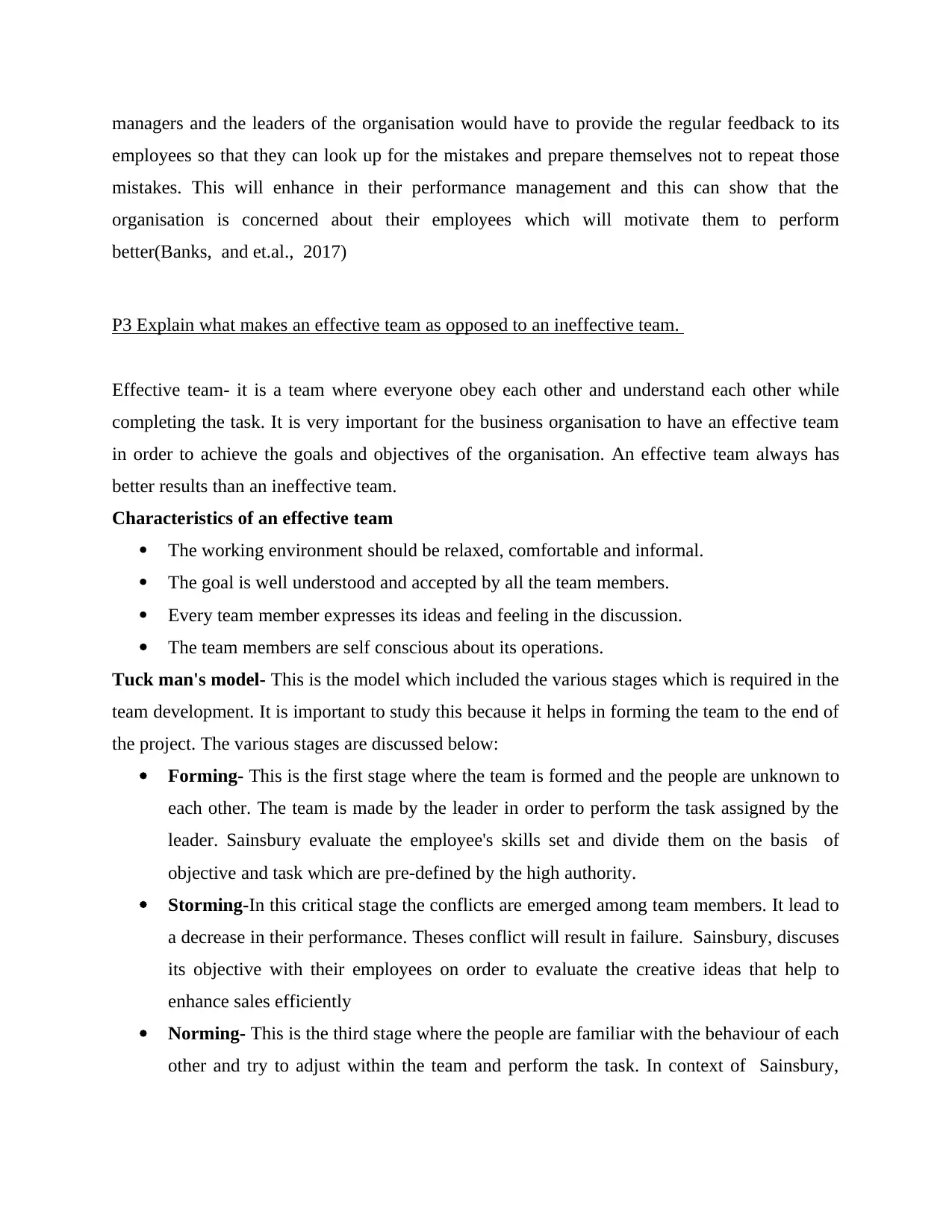
managers and the leaders of the organisation would have to provide the regular feedback to its
employees so that they can look up for the mistakes and prepare themselves not to repeat those
mistakes. This will enhance in their performance management and this can show that the
organisation is concerned about their employees which will motivate them to perform
better(Banks, and et.al., 2017)
P3 Explain what makes an effective team as opposed to an ineffective team.
Effective team- it is a team where everyone obey each other and understand each other while
completing the task. It is very important for the business organisation to have an effective team
in order to achieve the goals and objectives of the organisation. An effective team always has
better results than an ineffective team.
Characteristics of an effective team
The working environment should be relaxed, comfortable and informal.
The goal is well understood and accepted by all the team members.
Every team member expresses its ideas and feeling in the discussion.
The team members are self conscious about its operations.
Tuck man's model- This is the model which included the various stages which is required in the
team development. It is important to study this because it helps in forming the team to the end of
the project. The various stages are discussed below:
Forming- This is the first stage where the team is formed and the people are unknown to
each other. The team is made by the leader in order to perform the task assigned by the
leader. Sainsbury evaluate the employee's skills set and divide them on the basis of
objective and task which are pre-defined by the high authority.
Storming-In this critical stage the conflicts are emerged among team members. It lead to
a decrease in their performance. Theses conflict will result in failure. Sainsbury, discuses
its objective with their employees on order to evaluate the creative ideas that help to
enhance sales efficiently
Norming- This is the third stage where the people are familiar with the behaviour of each
other and try to adjust within the team and perform the task. In context of Sainsbury,
employees so that they can look up for the mistakes and prepare themselves not to repeat those
mistakes. This will enhance in their performance management and this can show that the
organisation is concerned about their employees which will motivate them to perform
better(Banks, and et.al., 2017)
P3 Explain what makes an effective team as opposed to an ineffective team.
Effective team- it is a team where everyone obey each other and understand each other while
completing the task. It is very important for the business organisation to have an effective team
in order to achieve the goals and objectives of the organisation. An effective team always has
better results than an ineffective team.
Characteristics of an effective team
The working environment should be relaxed, comfortable and informal.
The goal is well understood and accepted by all the team members.
Every team member expresses its ideas and feeling in the discussion.
The team members are self conscious about its operations.
Tuck man's model- This is the model which included the various stages which is required in the
team development. It is important to study this because it helps in forming the team to the end of
the project. The various stages are discussed below:
Forming- This is the first stage where the team is formed and the people are unknown to
each other. The team is made by the leader in order to perform the task assigned by the
leader. Sainsbury evaluate the employee's skills set and divide them on the basis of
objective and task which are pre-defined by the high authority.
Storming-In this critical stage the conflicts are emerged among team members. It lead to
a decrease in their performance. Theses conflict will result in failure. Sainsbury, discuses
its objective with their employees on order to evaluate the creative ideas that help to
enhance sales efficiently
Norming- This is the third stage where the people are familiar with the behaviour of each
other and try to adjust within the team and perform the task. In context of Sainsbury,
Paraphrase This Document
Need a fresh take? Get an instant paraphrase of this document with our AI Paraphraser
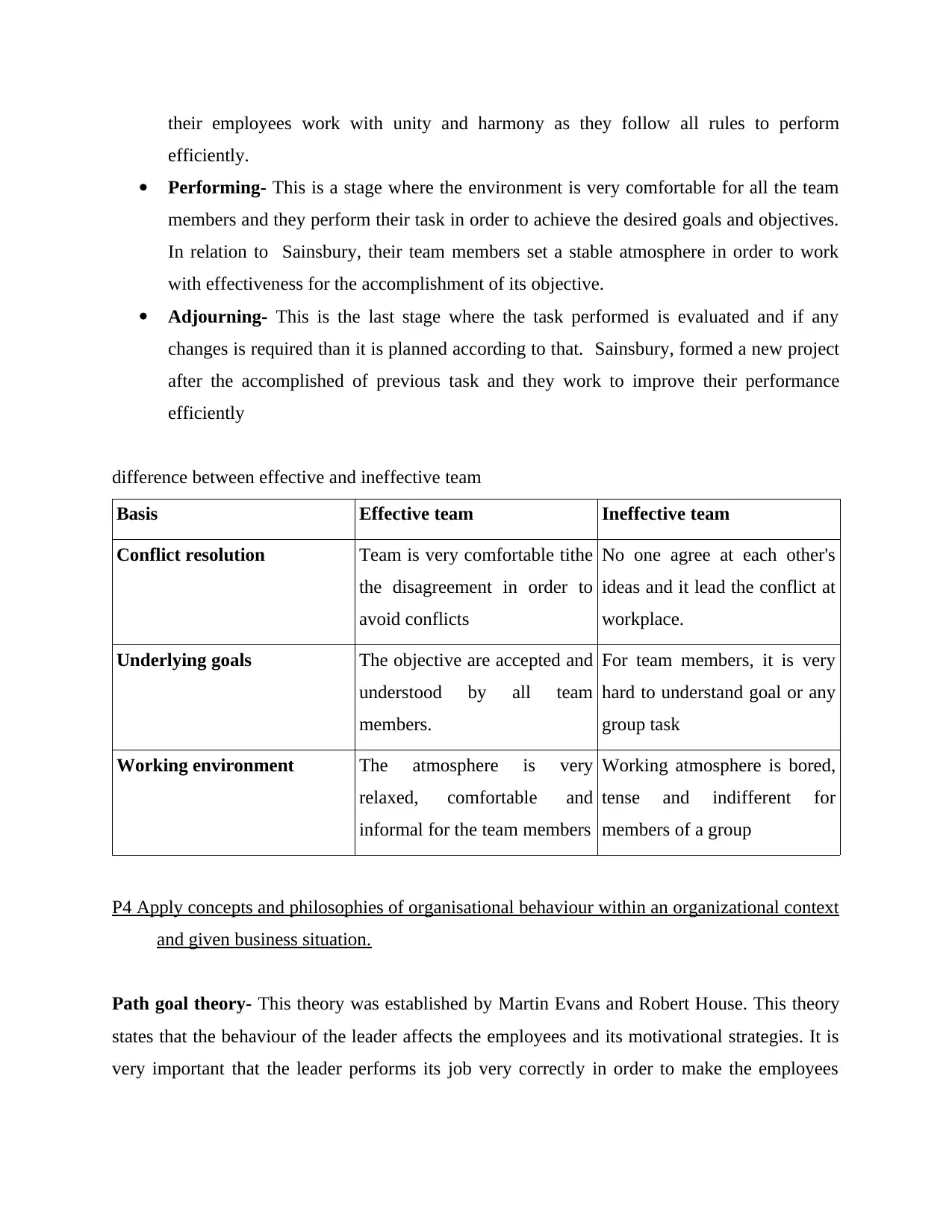
their employees work with unity and harmony as they follow all rules to perform
efficiently.
Performing- This is a stage where the environment is very comfortable for all the team
members and they perform their task in order to achieve the desired goals and objectives.
In relation to Sainsbury, their team members set a stable atmosphere in order to work
with effectiveness for the accomplishment of its objective.
Adjourning- This is the last stage where the task performed is evaluated and if any
changes is required than it is planned according to that. Sainsbury, formed a new project
after the accomplished of previous task and they work to improve their performance
efficiently
difference between effective and ineffective team
Basis Effective team Ineffective team
Conflict resolution Team is very comfortable tithe
the disagreement in order to
avoid conflicts
No one agree at each other's
ideas and it lead the conflict at
workplace.
Underlying goals The objective are accepted and
understood by all team
members.
For team members, it is very
hard to understand goal or any
group task
Working environment The atmosphere is very
relaxed, comfortable and
informal for the team members
Working atmosphere is bored,
tense and indifferent for
members of a group
P4 Apply concepts and philosophies of organisational behaviour within an organizational context
and given business situation.
Path goal theory- This theory was established by Martin Evans and Robert House. This theory
states that the behaviour of the leader affects the employees and its motivational strategies. It is
very important that the leader performs its job very correctly in order to make the employees
efficiently.
Performing- This is a stage where the environment is very comfortable for all the team
members and they perform their task in order to achieve the desired goals and objectives.
In relation to Sainsbury, their team members set a stable atmosphere in order to work
with effectiveness for the accomplishment of its objective.
Adjourning- This is the last stage where the task performed is evaluated and if any
changes is required than it is planned according to that. Sainsbury, formed a new project
after the accomplished of previous task and they work to improve their performance
efficiently
difference between effective and ineffective team
Basis Effective team Ineffective team
Conflict resolution Team is very comfortable tithe
the disagreement in order to
avoid conflicts
No one agree at each other's
ideas and it lead the conflict at
workplace.
Underlying goals The objective are accepted and
understood by all team
members.
For team members, it is very
hard to understand goal or any
group task
Working environment The atmosphere is very
relaxed, comfortable and
informal for the team members
Working atmosphere is bored,
tense and indifferent for
members of a group
P4 Apply concepts and philosophies of organisational behaviour within an organizational context
and given business situation.
Path goal theory- This theory was established by Martin Evans and Robert House. This theory
states that the behaviour of the leader affects the employees and its motivational strategies. It is
very important that the leader performs its job very correctly in order to make the employees
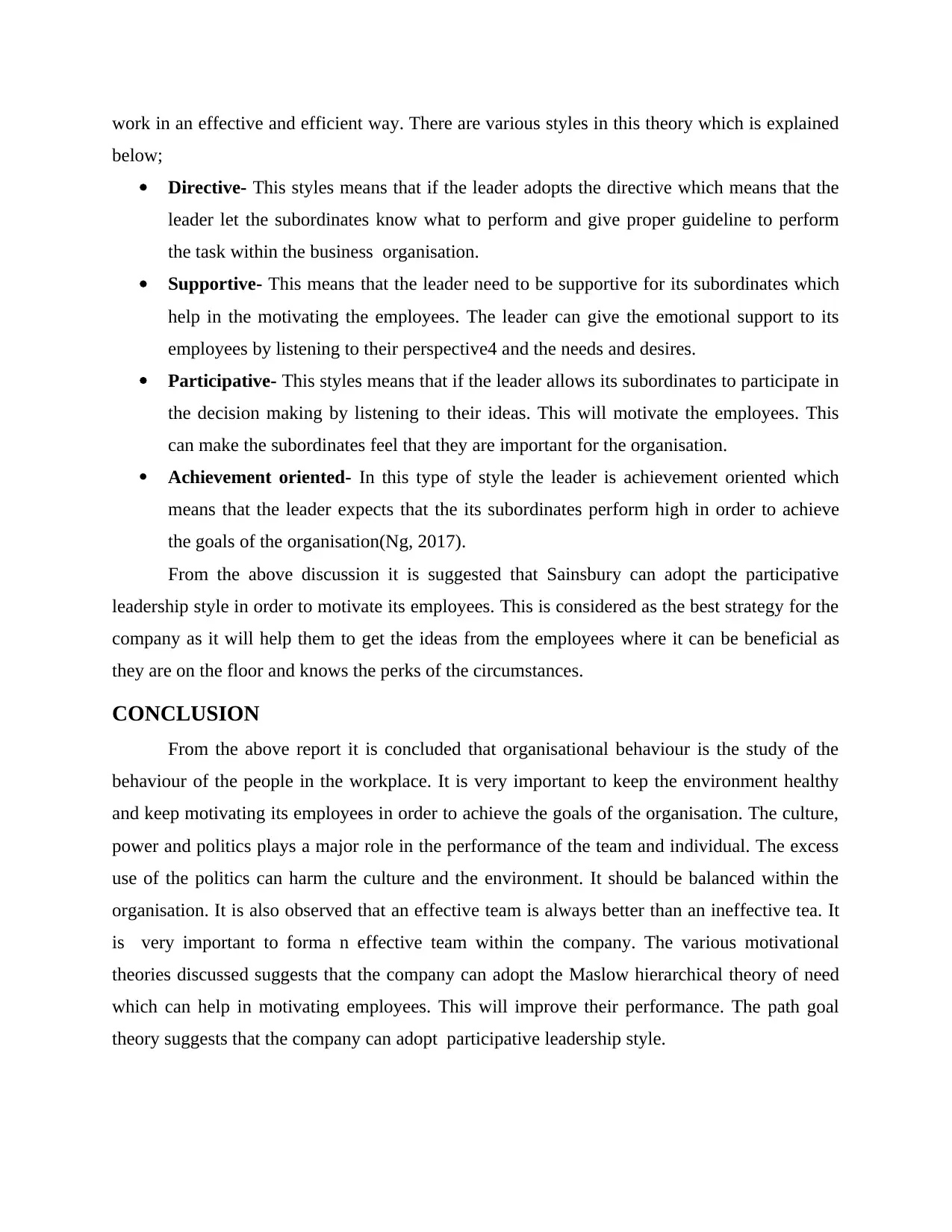
work in an effective and efficient way. There are various styles in this theory which is explained
below;
Directive- This styles means that if the leader adopts the directive which means that the
leader let the subordinates know what to perform and give proper guideline to perform
the task within the business organisation.
Supportive- This means that the leader need to be supportive for its subordinates which
help in the motivating the employees. The leader can give the emotional support to its
employees by listening to their perspective4 and the needs and desires.
Participative- This styles means that if the leader allows its subordinates to participate in
the decision making by listening to their ideas. This will motivate the employees. This
can make the subordinates feel that they are important for the organisation.
Achievement oriented- In this type of style the leader is achievement oriented which
means that the leader expects that the its subordinates perform high in order to achieve
the goals of the organisation(Ng, 2017).
From the above discussion it is suggested that Sainsbury can adopt the participative
leadership style in order to motivate its employees. This is considered as the best strategy for the
company as it will help them to get the ideas from the employees where it can be beneficial as
they are on the floor and knows the perks of the circumstances.
CONCLUSION
From the above report it is concluded that organisational behaviour is the study of the
behaviour of the people in the workplace. It is very important to keep the environment healthy
and keep motivating its employees in order to achieve the goals of the organisation. The culture,
power and politics plays a major role in the performance of the team and individual. The excess
use of the politics can harm the culture and the environment. It should be balanced within the
organisation. It is also observed that an effective team is always better than an ineffective tea. It
is very important to forma n effective team within the company. The various motivational
theories discussed suggests that the company can adopt the Maslow hierarchical theory of need
which can help in motivating employees. This will improve their performance. The path goal
theory suggests that the company can adopt participative leadership style.
below;
Directive- This styles means that if the leader adopts the directive which means that the
leader let the subordinates know what to perform and give proper guideline to perform
the task within the business organisation.
Supportive- This means that the leader need to be supportive for its subordinates which
help in the motivating the employees. The leader can give the emotional support to its
employees by listening to their perspective4 and the needs and desires.
Participative- This styles means that if the leader allows its subordinates to participate in
the decision making by listening to their ideas. This will motivate the employees. This
can make the subordinates feel that they are important for the organisation.
Achievement oriented- In this type of style the leader is achievement oriented which
means that the leader expects that the its subordinates perform high in order to achieve
the goals of the organisation(Ng, 2017).
From the above discussion it is suggested that Sainsbury can adopt the participative
leadership style in order to motivate its employees. This is considered as the best strategy for the
company as it will help them to get the ideas from the employees where it can be beneficial as
they are on the floor and knows the perks of the circumstances.
CONCLUSION
From the above report it is concluded that organisational behaviour is the study of the
behaviour of the people in the workplace. It is very important to keep the environment healthy
and keep motivating its employees in order to achieve the goals of the organisation. The culture,
power and politics plays a major role in the performance of the team and individual. The excess
use of the politics can harm the culture and the environment. It should be balanced within the
organisation. It is also observed that an effective team is always better than an ineffective tea. It
is very important to forma n effective team within the company. The various motivational
theories discussed suggests that the company can adopt the Maslow hierarchical theory of need
which can help in motivating employees. This will improve their performance. The path goal
theory suggests that the company can adopt participative leadership style.
⊘ This is a preview!⊘
Do you want full access?
Subscribe today to unlock all pages.

Trusted by 1+ million students worldwide
1 out of 14
Related Documents
Your All-in-One AI-Powered Toolkit for Academic Success.
+13062052269
info@desklib.com
Available 24*7 on WhatsApp / Email
![[object Object]](/_next/static/media/star-bottom.7253800d.svg)
Unlock your academic potential
Copyright © 2020–2025 A2Z Services. All Rights Reserved. Developed and managed by ZUCOL.





